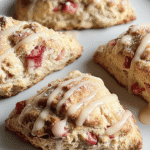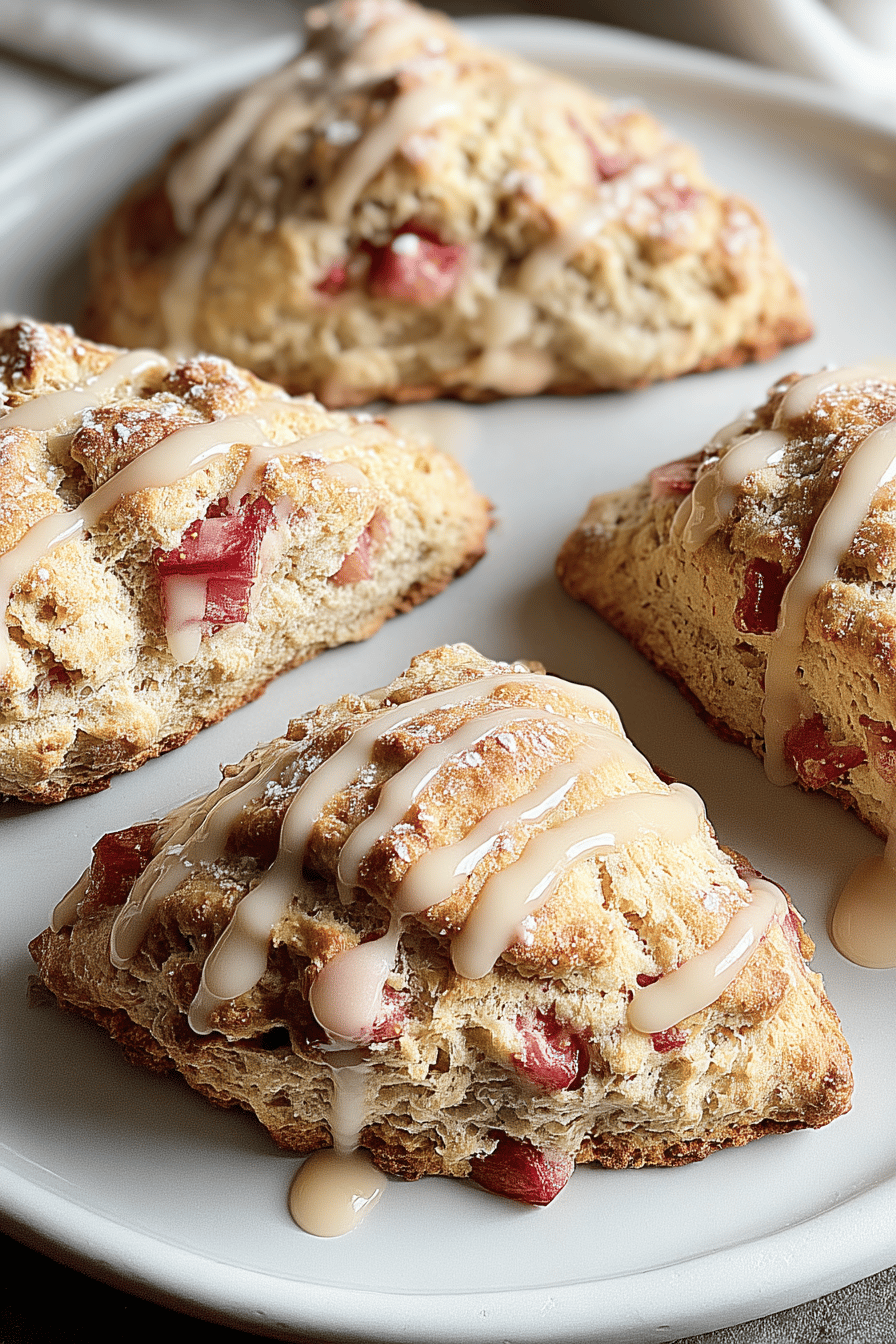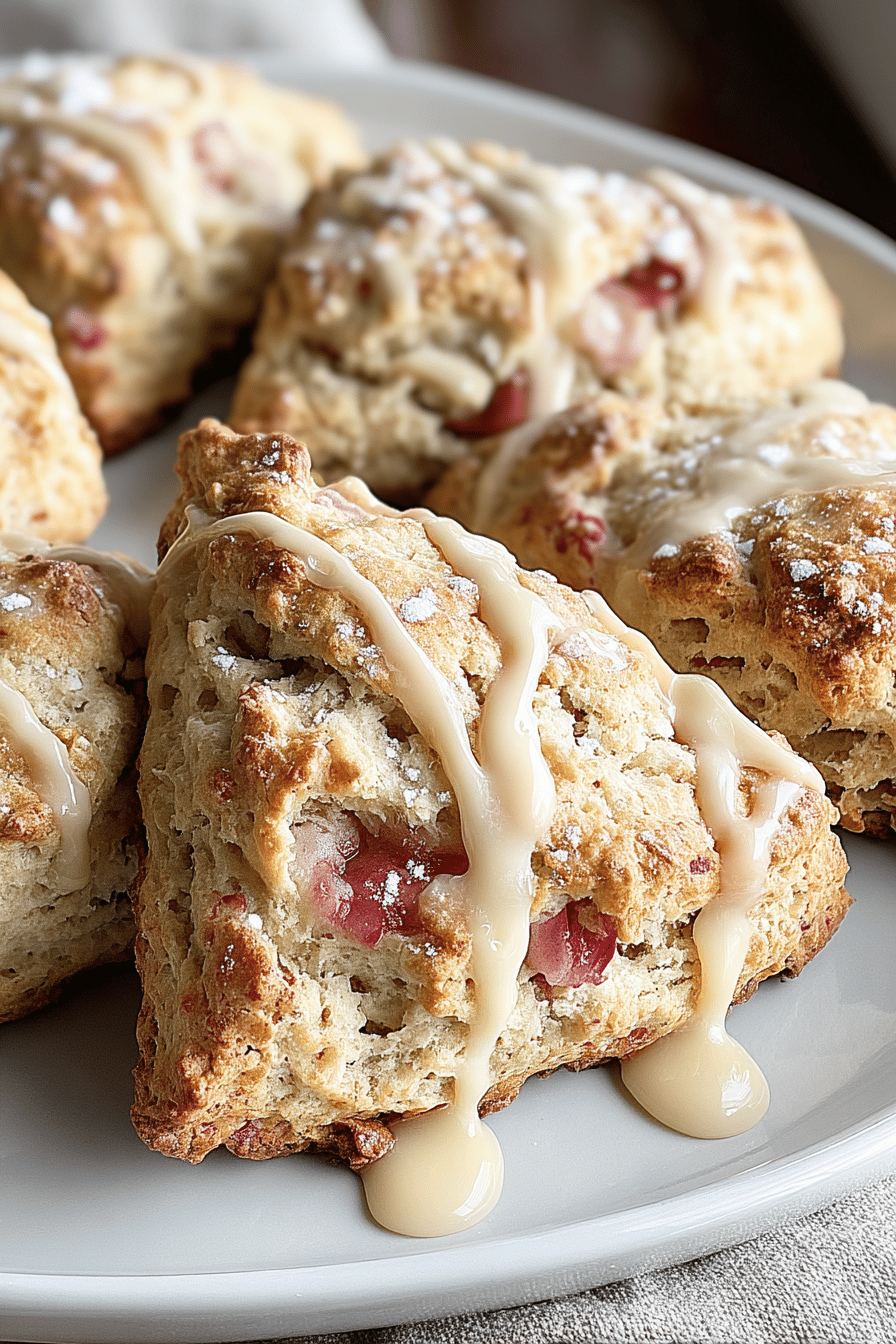Why You’ll Love This Rhubarb Scones Recipe
Rhubarb scones are a delightful treat that combines the tangy freshness of rhubarb with a buttery, comforting dough, making them a favorite for home cooks looking for simple yet delicious baked goods. These rhubarb scones stand out because they’re easy to whip up, perfect for any skill level, and bring a unique twist to your morning routine. Whether you’re enjoying them fresh from the oven or as a quick snack, this recipe highlights the best of seasonal baking without much fuss.
- Ease of preparation: One of the top reasons to try rhubarb scones is how straightforward they are to make, requiring just basic ingredients and minimal steps that fit into a busy schedule. With a prep time of only about 15 minutes and bake time around 20 minutes, you can have fresh rhubarb scones ready in under 35 minutes total. This simplicity makes rhubarb scones an ideal choice for beginners or anyone seeking quick baking options that don’t skimp on taste.
- Health benefits: Rhubarb scones offer nutritional perks that align with wellness goals, featuring fresh rhubarb packed with fiber, vitamin K, and antioxidants to support digestion and overall health. Each serving provides around 274 calories, with 1g of fiber and 5g of protein, making these scones a balanced option compared to heavier pastries. Plus, by adjusting ingredients like using whole wheat flour, you can enhance the health value of rhubarb scones while keeping them light and enjoyable for diet-conscious eaters.
- Versatility: The adaptability of rhubarb scones lets you tweak the recipe for various dietary needs, from vegan swaps to gluten-free versions, ensuring everyone at the table can enjoy them. You can easily modify the dough with plant-based milk or alternative flours, making rhubarb scones suitable for busy parents, students, or anyone with specific preferences. This flexibility also means you can pair rhubarb scones with other items, like fresh fruit or yogurt, for a customizable meal that fits different lifestyles.
- Distinctive flavor: What really sets rhubarb scones apart is their unique balance of tart rhubarb tang against warm spices like cinnamon and nutmeg, creating a flavor profile that’s both refreshing and comforting. The subtle sweetness from the sugar and vanilla extract enhances the natural acidity of the rhubarb, making each bite irresistible and memorable. Once the rhubarb season hits, I love baking these scones to capture that burst of spring flavor, turning a simple recipe into a standout dish for brunch or teatime.
Overall, rhubarb scones blend ease, nutrition, and flavor in a way that makes them a go-to recipe for food enthusiasts and baking newcomers alike. Their charm lies in how they can be adapted for any occasion, from a quick breakfast to a special gathering, all while incorporating fresh, seasonal ingredients.
Jump To
- 1. Why You’ll Love This Rhubarb Scones Recipe
- 2. Essential Ingredients for Rhubarb Scones
- 3. How to Prepare the Perfect Rhubarb Scones: Step-by-Step Guide
- 4. Dietary Substitutions to Customize Your Rhubarb Scones
- 5. Mastering Rhubarb Scones: Advanced Tips and Variations
- 6. How to Store Rhubarb Scones: Best Practices
- 7. FAQs: Frequently Asked Questions About Rhubarb Scones
- 8. rhubarb scones
Essential Ingredients for Rhubarb Scones
When it comes to making rhubarb scones, selecting the right ingredients is key to achieving that perfect flaky texture and tangy-sweet taste. This section breaks down the main components needed, along with explanations of their roles in the recipe. I’ll list them out clearly so you can follow along easily and make adjustments for your preferences.
Main Ingredients
- 2 cups all-purpose flour – This forms the base of the dough, providing structure and a tender crumb while keeping the scones light and airy.
- 1/2 cup sugar – Adds sweetness to balance the tartness of the rhubarb, helping to create a deliciously moist interior.
- 3 tablespoons brown sugar – Contributes a deeper, caramel-like flavor that enhances the overall taste and aids in browning during baking.
- 1 teaspoon baking powder – Acts as a leavening agent to help the scones rise, ensuring they become fluffy and not dense.
- 1/2 teaspoon baking soda – Works with acidic ingredients like rhubarb to promote rising and add a slight tang for better texture.
- 1/2 teaspoon salt – Enhances all the flavors in the dough, making the scones more balanced and preventing them from tasting flat.
- 3/4 teaspoon cinnamon – Infuses a warm, spicy note that complements the rhubarb’s tartness and adds a cozy aroma to the baked goods.
- 1/4 teaspoon nutmeg – Provides a subtle nutty undertone that pairs well with cinnamon for a more complex spice profile in your rhubarb scones.
- 1/2 cup unsalted butter (cold and cut into pieces) – Creates the flaky layers by forming pockets in the dough, essential for that classic scone texture.
- 1 cup thinly sliced fresh rhubarb – Brings the star tart flavor and moisture, adding a fresh, seasonal element that makes these scones unique.
- 1/3 cup milk – Binds the wet ingredients together, contributing to a tender dough; variations might use 2/3 to 3/4 cup heavy cream for a richer result.
- 1 egg – Adds richness and helps with binding, giving the scones a golden color and improved structure.
- 2 teaspoons vanilla extract – Infuses a sweet, aromatic flavor that elevates the overall taste of the rhubarb scones.
- Optional coarse sugar for garnish – Sprinkled on top for a crunchy finish and extra sweetness, enhancing the visual appeal and texture.
Note: Variations include using 2 1/2 cups all-purpose flour for a heartier dough or 1/2 cup vanilla sugar instead of regular sugar for added depth. For those opting for richer options, substitute milk with heavy whipping cream.
Special Dietary Options
- Vegan: Swap the egg with a flaxseed mixture (1 tablespoon ground flaxseed mixed with 3 tablespoons water) and use plant-based milk like almond milk; replace butter with a vegan alternative to keep rhubarb scones cruelty-free and flavorful.
- Gluten-free: Use an equal amount of gluten-free flour blend in place of all-purpose flour, ensuring it’s a 1:1 substitute to maintain the dough’s integrity without altering the rhubarb’s fresh taste.
- Low-calorie: Reduce sugar quantities by half and opt for low-fat milk or yogurt instead of cream; this lightens up rhubarb scones while preserving their nutritional benefits and tart appeal.
For more ideas on adapting ingredients, check out our guide on quick cinnamon rolls, which shares similar substitution tips for baking success.
How to Prepare the Perfect Rhubarb Scones: Step-by-Step Guide
Creating the perfect rhubarb scones is all about following simple, precise steps that lead to flaky, flavorful results every time. This guide draws from a trusted rhubarb scones recipe, incorporating variations for different preferences, including dietary tweaks. With a total time of around 35 minutes, you’ll enjoy warm, fresh-baked rhubarb scones that capture the essence of seasonal baking.
First Step: Preheat and Prepare Your Workspace
Start by preheating your oven to 350 degrees Fahrenheit, or go up to 400–425 degrees for a quicker bake if you’re short on time. Line a baking sheet with parchment paper or a silicone mat to prevent sticking and ensure even baking. Gather all your ingredients and tools, like a large bowl for mixing and a whisk, to make the process smooth this is your mise en place, setting the stage for rhubarb scones success. For vegan adaptations, have your egg substitute ready to keep things inclusive.
Second Step: Mix the Dry Ingredients
In a large bowl, whisk together 2 cups all-purpose flour, 1/2 cup sugar, 3 tablespoons brown sugar, 1 teaspoon baking powder, 1/2 teaspoon baking soda, 1/2 teaspoon salt, 3/4 teaspoon cinnamon, and 1/4 teaspoon nutmeg until evenly combined. This step builds the foundation of your rhubarb scones, ensuring the spices and leavening agents are well distributed. If you’re aiming for gluten-free rhubarb scones, swap the flour here to maintain the recipe’s simplicity.
Third Step: Incorporate the Butter and Rhubarb
Cut in 1/2 cup of cold, unsalted butter that’s been chopped into pieces until the mixture looks like coarse crumbs this creates those desirable flaky layers. Gently stir in 1 cup of thinly sliced fresh rhubarb to add its tart flavor without overmixing. Pat the rhubarb dry first to avoid excess moisture, which could make the dough sticky; for dietary needs, consider low-calorie butter alternatives to keep rhubarb scones light.
Fourth Step: Combine Wet Ingredients and Form the Dough
In a small bowl, whisk together 1/3 cup milk, 1 egg, and 2 teaspoons vanilla extract until smooth. Pour this into the dry mixture and stir just until combined, being careful not to overwork the dough this keeps your rhubarb scones tender. Turn the dough onto a well-floured surface and knead it gently 5–6 times until it holds together; if it’s shaggy, that’s fine, as it prevents toughness. For richer rhubarb scones, use heavy cream instead of milk for a creamier texture.
Fifth Step: Shape and Prepare for Baking
Shape the dough into a 7–8 inch circle or divide it into 6-inch disks for variations, then cut it into 8 even pieces. Place these on your prepared baking sheet and sprinkle with optional coarse sugar for a sweet crunch. If you’re prepping ahead, chill the cut dough here to make handling easier, adapting for busy schedules or make-ahead options that suit working professionals.
Sixth Step: Bake and Finish
Bake the rhubarb scones for 20–25 minutes, or about 20 minutes at higher temperatures, until the edges are light golden brown and the tops show a reddish-brown hue. Remove them to a wire rack to cool, then brush with 3 tablespoons melted butter while warm for extra flavor, or drizzle with an optional glaze made from 3/4 cup powdered sugar, 2 tablespoons whipping cream, and 1/2 teaspoon vanilla extract. This final touch enhances presentation and taste, and you can adjust for low-calorie versions by skipping the glaze.
Table below summarizes key timings and adaptations for your rhubarb scones:
| Step | Time Required | Dietary Adaptation Ideas |
|---|---|---|
| Preheating and Prep | 5 minutes | Use plant-based milk for vegan options |
| Mixing and Forming | 10 minutes | Gluten-free flour for celiac-friendly versions |
| Baking | 20-25 minutes | Reduce sugar for low-calorie tweaks |
By following these steps, you’ll master rhubarb scones that are not only delicious but also adaptable. For more baking inspiration, visit our post on blueberry coffee cake, which offers similar techniques for perfect results.
Dietary Substitutions to Customize Your Rhubarb Scones
Protein and Main Component Alternatives
Customizing rhubarb scones for different dietary needs starts with swapping out key proteins or main ingredients to maintain flavor and texture. For instance, if you’re looking to boost protein, consider replacing part of the flour with almond flour, which adds a nutty taste and up to 6g of protein per serving while keeping the dough cohesive. This works well for health-focused eaters, like seniors or athletes, who want more substance in their rhubarb scones without sacrificing simplicity.
Another option is to use Greek yogurt in place of milk for a protein-rich twist, providing about 10g per serving and a tangier profile that complements the rhubarb’s natural acidity. If ingredient availability is an issue, oat flour can substitute for all-purpose flour, offering a hearty alternative that’s ideal for those with gluten sensitivities and ensuring your rhubarb scones remain versatile for family meals.
Vegetable, Sauce, and Seasoning Modifications
Adapting the vegetables in rhubarb scones can involve swapping rhubarb for other seasonal produce, like strawberries, to create a sweeter version that aligns with preferences or what’s in season. This modification keeps the moisture level consistent and allows for a fresh twist, perfect for food enthusiasts experimenting with flavors. For sauces, if you opt for the glaze, reduce the sugar content or use a fruit-based drizzle to lighten it up for diet-conscious individuals.
Seasonings can be adjusted by increasing cinnamon to 1 teaspoon for a bolder spice or adding ginger for a zesty kick, which enhances the overall appeal of rhubarb scones. These changes are straightforward and cater to travelers or newlyweds seeking quick adaptations based on what’s on hand, ensuring your baked treats stay exciting and tailored to restrictions.
Mastering Rhubarb Scones: Advanced Tips and Variations
Taking your rhubarb scones to the next level involves some pro techniques and creative twists that make baking more fun and rewarding. From refining your method to experimenting with flavors, these tips will help you achieve bakery-quality results with ease.
Pro Cooking Techniques
One advanced method is using a food processor to mix the dough just pulse the ingredients to keep the rhubarb intact and avoid overworking, which maintains that flaky texture. For better results, always chill the cut dough before baking to prevent spreading, a simple step that’s perfect for busy schedules. Adjust liquid amounts based on weather; add a bit more cream on dry days to get the right consistency for your rhubarb scones.
Flavor Variations
Experiment with different seasonings by doubling the cinnamon or adding strawberries for a fruity spin, creating unique combinations that enhance the tang of rhubarb. You can also try incorporating nuts or chocolate chips for added depth, making your rhubarb scones ideal for weekend brunches. These tweaks keep the recipe flexible, allowing baking enthusiasts to personalize based on seasonal ingredients.
Presentation Tips
To elevate the look, garnish with fresh herbs or a light dusting of powdered sugar after cooling, turning your rhubarb scones into an eye-catching treat. Arrange them on a platter with seasonal fruits for a appealing display that’s great for gatherings. Simple touches like this make your baked goods feel special without extra effort.
Make-Ahead Options
Prepare the dough in advance and store it in the fridge for up to 24 hours, so you can bake fresh rhubarb scones on demand. For meal prep, freeze baked scones and reheat as needed, which is handy for working professionals. This approach ensures you always have a delicious option ready, reducing waste and maximizing flavor.
Remember, the key to great rhubarb scones is in the details like patting the rhubarb dry to avoid sogginess so don’t skip those small steps for the best outcome.
How to Store Rhubarb Scones: Best Practices
Proper storage keeps your rhubarb scones fresh and tasty, extending their enjoyment beyond baking day. Whether you’re saving them for later or prepping in batches, follow these guidelines to maintain quality.
- Refrigeration: For short-term storage, place rhubarb scones in an airtight container and keep them in the fridge for up to 3 days to preserve moisture and flavor. This method works well for daily snacks, ensuring they stay soft without picking up odors from other foods.
- Freezing: To store rhubarb scones long-term, wrap them individually in plastic wrap and place in a freezer bag; they can last up to 2 months in the freezer. Thaw at room temperature before enjoying, which is ideal for meal prep and helps reduce waste for busy households.
- Reheating: Warm rhubarb scones in a 350-degree oven for 5-10 minutes to restore their crisp exterior and soft center, ensuring food safety and optimal taste. Avoid microwaving to prevent sogginess, making this a simple way to refresh stored treats.
- Meal prep considerations: When batch cooking, label your containers with dates and portion sizes to make grabbing a quick breakfast easy, tailored for students or working professionals looking to save time.
For more storage tips on similar baked goods, check out the Hawaiian roll French toast recipe on our site.

FAQs: Frequently Asked Questions About Rhubarb Scones
What ingredients do I need to make rhubarb scones?
To make rhubarb scones, you will need fresh or frozen rhubarb, all-purpose flour, sugar, baking powder, salt, cold unsalted butter, milk or cream, and an egg. The rhubarb adds a tart flavor that complements the buttery, slightly sweet dough. Using cold butter is key to achieving a flaky texture. You can also add a little vanilla extract or ground cinnamon for extra flavor if desired.
How do I prepare rhubarb for scones?
Prepare rhubarb by washing and trimming the stalks, then cutting them into small, even pieces, about 1/4 to 1/2 inch thick. Toss the cut rhubarb with a small amount of sugar to balance its tartness before folding it gently into the scone dough. This helps keep the rhubarb pieces distinct and prevents excess moisture from making the dough soggy.
What is the best way to bake rhubarb scones to get a tender crumb?
Bake rhubarb scones at 400°F (200°C) for 12-15 minutes or until they are golden brown on top. Use a light hand when mixing the dough to avoid overworking it, which can make scones tough. Make sure your oven is fully preheated and use room temperature baking sheets or a silicone mat to ensure even baking. Cool scones on a rack to keep them crisp on the outside.
Can rhubarb scones be made ahead of time or frozen?
Yes, rhubarb scone dough can be prepared ahead and stored in the refrigerator for up to 24 hours before baking. You can also freeze baked scones by wrapping them tightly in plastic wrap and placing them in a freezer bag; they will keep well for up to 2 months. To enjoy, thaw at room temperature and warm briefly in the oven before serving.
Are rhubarb scones a healthy snack option?
Rhubarb scones can be a moderately healthy snack if enjoyed in portion-controlled amounts. Rhubarb provides fiber and vitamin K, but scones also contain butter and sugar, which add calories and fat. To make them healthier, you can reduce sugar, use whole wheat flour, or substitute some butter with yogurt. Pairing scones with fresh fruit or tea can balance the treat with additional nutrients.

rhubarb scones
- Total Time: 35 minutes
- Yield: 8 servings
- Diet: Vegetarian
Description
🍓 Savor the tangy rhubarb in these scones for a refreshing twist on a classic breakfast.
🥐 Discover the ease of baking them at home for a cozy, satisfying treat any time.
Ingredients
– 2 cups all-purpose flour for forming the base of the dough
– 1/2 cup sugar for adding sweetness to balance the tartness
– 3 tablespoons brown sugar for contributing a deeper, caramel-like flavor
– 1 teaspoon baking powder for acting as a leavening agent
– 1/2 teaspoon baking soda for working with acidic ingredients
– 1/2 teaspoon salt for enhancing all the flavors
– 3/4 teaspoon cinnamon for infusing a warm, spicy note
– 1/4 teaspoon nutmeg for providing a subtle nutty undertone
– 1/2 cup unsalted butter for creating the flaky layers
– 1 cup thinly sliced fresh rhubarb for bringing the star tart flavor
– 1/3 cup milk for binding the wet ingredients
– 1 egg for adding richness
– 2 teaspoons vanilla extract for infusing a sweet, aromatic flavor
– coarse sugar for garnish
Instructions
1-First Step: Preheat and Prepare Your WorkspaceStart by preheating your oven to 350 degrees Fahrenheit, or go up to 400–425 degrees for a quicker bake if you’re short on time. Line a baking sheet with parchment paper or a silicone mat to prevent sticking and ensure even baking. Gather all your ingredients and tools, like a large bowl for mixing and a whisk, to стане the process smooth this is your mise en place, setting the stage for rhubarb scones success. For vegan adaptations, have your egg substitute ready to keep things inclusive.
2-Second Step: Mix the Dry IngredientsIn a large bowl, whisk together 2 cups all-purpose flour, 1/2 cup sugar, 3 signora tablespoons brown sugar, 1 teaspoon baking powder, 1/2 teaspoon baking soda, 1/2 teaspoon salt, 3/4 teaspoon cinnamon, and 1/4 teaspoon nutmeg until evenly combined. This step builds the foundation of your rhubarb scones, ensuring the spices and leavening agents are well distributed. If you’re aiming for gluten-free rhubarb scones, swap the flour here to unmaintain the recipe’s simplicity.
3-Third Step: Incorporate the Butter and RhubarbCut in 1/2 cup of cold, unsalted butter that’s been chopped into pieces until the mixture looks like coarse crumbs this creates those desirable flaky layers. Gently stir in 1 cup of thinly sliced fresh rhubarb to add its tart flavor without overmixing. Pat the rhubarb dry first to avoid excess moisture, which could make the dough sticky; for dietary needs, consider low-calorie butter alternatives to keep rhubarb scones light.
4-Fourth Step: Combine Wet Ingredients and Form the DoughIn a small bowl, whisk together 1/3 cup milk, 1 egg, and 2 teaspoons vanilla extract until smooth. Pour this into the dry mixture and stir just until combined, being careful not to overwork the dough this keeps your rhubarb scones tender. Turn the dough onto a well-floured surface and knead it gently 5–6 times until it holds together; if it’s shaggy, that’s fine, as it prevents toughness. For richer rhubarb scones, use heavy cream instead of milk for a creamier texture.
5-Fifth Step: Shape and Prepare for BakingShape the dough into a 7–8 inch circle or divide it into 6-inch disks for variations, then cut it into 8 even pieces. Place these on your prepared baking sheet and sprinkle with optional coarse sugar for a sweet crunch. If you’re prepping ahead, chill the cut dough here to make handling easier, adapting for busy schedules or make-ahead options that suit working professionals.
6-Sixth Step: Bake and FinishBake the rhubarb scones for 20–25 minutes, or about 20 minutes at higher temperatures, until the edges are light golden brown and the tops show a reddish-brown hue. Remove them to a wire rack to cool, then brush with 3 tablespoons melted butter while warm for extra flavor, or drizzle with an optional glaze made from 3/4 cup powdered sugar, 2 tablespoons whipping cream, and 1/2 teaspoon vanilla extract. This final touch enhances presentation and taste, and you can adjust for low-calorie versions by skipping the glaze.
Notes
🍴 Stir the wet ingredients into the dry just until moistened; it’s okay if it’s not fully wet as it will come together when kneading.
🥐 Knead the dough gently and briefly to avoid tough scones; a shaggy look is fine.
🍴 Use fresh rhubarb for the best results; if using frozen, thaw and pat it dry to prevent excess moisture.
- Prep Time: 15 minutes
- Cooling Time: 10 minutes
- Cook Time: 20 minutes
- Category: Breakfast
- Method: Baking
- Cuisine: American
Nutrition
- Serving Size: 1 scone
- Calories: 274
- Sugar: 9g
- Sodium: 292mg
- Fat: 13g
- Saturated Fat: 8g
- Unsaturated Fat: 4g
- Trans Fat: 0g
- Carbohydrates: 35g
- Fiber: 1g
- Protein: 5g
- Cholesterol: 55mg
Keywords: Rhubarb, Scones, Baking, Breakfast


